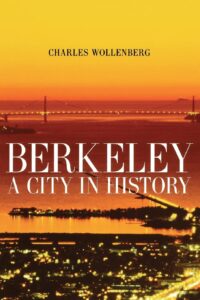Berkeley: A City History – Charles Wollenberg
In 2009, I packed my bags and drove all the way across country from the East Coast to my new home in Oakland. I came to the Bay Area knowing nothing about its history. I landed a job at a used bookstore in Berkeley, and one of the first things I noticed about much of Berkeley was how much history was embodied in its buildings, its landscapes, and its human features. But I never really investigated the city beyond my every day lived experiences.
Fourteen years later and back in Virginia, I came across Berkeley: A City History online, and decided to buy it, wanting to know more of the place that changed my life in just two short years. Wollenberg’s book is a brief and concise history of the growth of the land and people in Berkeley from a region inhabited by Indigenous peoples to the modern city it is today. He makes sure to include the diversity that still characterizes the city.
While informative, I found most of Wollenberg’s narrative to be very surface, and I am guessing he intended it to be that way. I would love to read a deeper analysis of Berkeley’s history, one that focuses even more on the diversity of its inhabitants, from pre-colonial times to present. How has affluent white and poor minority populations living so densely packed together influenced the history of the city? How have national chains affected the proliferation of local business even into the twenty-first century? The used bookstore I worked at was actually a chain (which I didn’t know until after I applied) but Berkeleyites often mistook it for a used bookstore like Moe’s and this made them proud to patronize our business. Berkeley is full of fiercely independent people who want to keep businesses local and the arts flourishing. They pride themselves on the academic cornerstone of UC Berkely in their midst.
If you are looking for a compact history of one of the San Francisco Bay Area’s, and perhaps the country’s, most important cities, this is a good book for you. It leads the door open for more focused and detailed history of student protest (that has already been written about), race relations, class relations, deeper dives into urban and suburban history, the history of urban/mass transit, and many more subdisciplines.
 Berkeley: A City History. By Charles Wollenberg. (Berkeley: University of California Press, 2008. pp. 224. Paper, $26.95.)
Berkeley: A City History. By Charles Wollenberg. (Berkeley: University of California Press, 2008. pp. 224. Paper, $26.95.)